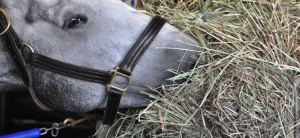 While chemical analysis of hay represents the gold-standard for evaluation of hay for horses, horse owners can tell plenty about a hay’s quality by a thorough visual examination.
While chemical analysis of hay represents the gold-standard for evaluation of hay for horses, horse owners can tell plenty about a hay’s quality by a thorough visual examination.
Physical characteristics of hay quality include plant type, maturity at harvest, color, and moisture content.
Plant Type:
For experienced horsemen, identifying the plants that compose individual bales of hay may be simple. Certain plants are easily discernible. Other plants may be more difficult to classify. An expert may be needed to identify miscellaneous grasses or unusual plants. Note suspect weeds as well. Generally speaking, the purer the bale, the higher quality the hay.
Hay Maturity:
Determine hay maturity. The presence of seed heads, stem coarseness, and a low leaf-to-stem ratio helps to determine. Though they frequently have higher yields, first cutting hays are apt to be more mature than later cuttings. Second and third cuttings tend to have fewer stems and more leaves, which make them more nutritious, as leaves are rich in nonstructural carbohydrates and protein, and low in structural carbohydrates.
Color:
Color is not the end-all, be-all of hay evaluation, yet the most desirable hays are typically bright green. A green color is also indicative of the amount of alpha-tocopherol (Vitamin E) and beta-carotene (Vitamin A) in the hay. A yellow or light-brown color points to rain damage, sun-bleaching, or overmaturity at harvest. Sun-bleaching occurs during storage. Hay exposed to direct light, especially. In these instances, though, the majority of a bale might still be green with just discolored edges.
Moisture Content:
Hay quality is dependent on proper harvesting. Most notably, dry hay to less than 20% moisture. Hay baled too wet will mold and be unsuitable for consumption by horses. Hay baled too dry is predisposed to leaf shatter (disintegration of leaves) or leaf loss. Legumes are especially prone to leaf shatter.
In conclusion, conduct evaluation through the senses. However, remember, chemical analysis of hay represents the gold-standard for evaluation of hay for horses! That’s why North Fulton‘s sister store, Cherokee Feed & Seed, along with Purina Animal Nutrition offer free hay and forage testing services!
Article source: KER.
